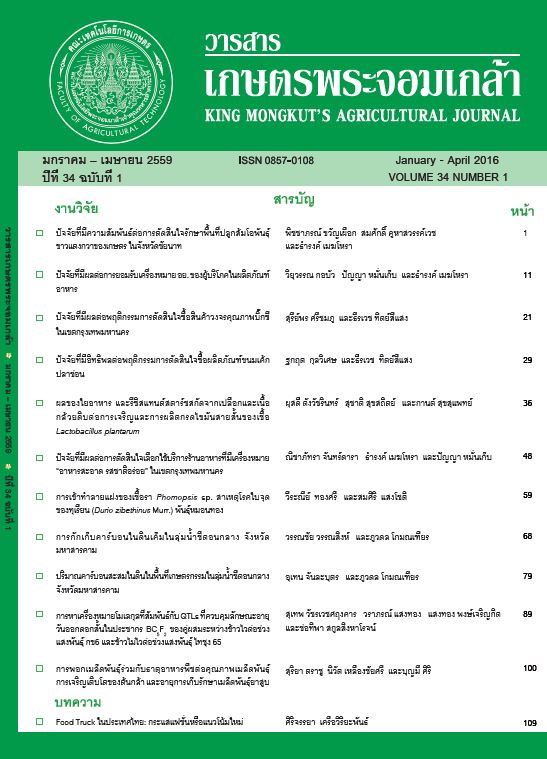การเข้าทำลายแฝงของเชื้อรา Phomopsis sp. สาเหตุโรคใบจุดของทุเรียน (Durio zibethinus Murr.) พันธุ์หมอนทอง
Main Article Content
บทคัดย่อ
โรคใบจุดของทุเรียน มีสาเหตุจากเชื้อรา Phomopsis sp. เป็นโรคที่ไม่ได้ก่อความเสียหายต่อทุเรียนโดยตรง
แต่การสะสมของโรคที่ใบจะเป็นแหล่งของเชื้อและก่อให้เกิดโรคผลเน่าภายหลังการเก็บเกี่ยวได้ ในงานวิจัยนี้มุ่งเน้น
ศึกษาระยะเข้าทำลายแฝง และปัจจัยภายในพืชที่ก่อให้เกิดการเข้าทำลายแฝงของเชื้อสาเหตุโรค โดยเมื่อปลูกเชื้อรา
Phomopsis sp. ด้วยวิธีพ่นสปอร์แขวนลอย (เข้มข้น 106 สปอร์/มล.) ลงบนต้นกล้าทุเรียนที่หลังหรือท้องใบ พบว่า
บริเวณท้องใบเกิดการติดเชื้อมากกว่า และเมื่อปลูกเชื้อโดยวิธีวางชิ้นวุ้นลงบนแผลจะพบลักษณะจุดตายสีน้ำตาลบน
เนื้อเยื่อใบ และมีการสร้างส่วนขยายพันธุ์ของเชื้อรา เรียกว่า pycnidium ที่ 20 วันหลังจากปลูกเชื้อ และยังพบลักษณะ
เข้าทำลายแฝงของเชื้อก่อโรค โดยมีการปรากฏแผลใหม่ซึ่งมีลักษณะอาการแผลจุดสีน้ำตาลเข้มขนาดเส้นผ่าศูนย์กลาง
1 มม. และมีวงแหวนสีเหลืองล้อมรอบหลังจากปลูกเชื้อที่ 32 วัน รวมทั้งยังพบการเข้าทำลายแฝงในสภาพธรรมชาติ
โดยสามารถตรวจพบการติดเชื้อของเชื้อรา Phomopsis spp. ทั้งบนใบและดอกที่ปราศจากอาการโรคสูงถึง 95 และ
70% ตามลำดับ ยิ่งไปกว่านั้นการที่สารสกัดหยาบจากใบทุเรียนสามารถลดการงอกและความยาวของ germ tube
ของสปอร์เชื้อรา และการปรากฏของสารที่มีคุณสมบัติยับยั้งการเจริญของเชื้อราสาเหตุโรคบนแผ่น TLC ที่ retention
factor 0.29-0.88 แสดงถึงเนื้อเยื่อใบทุเรียนมีสารบางชนิดที่ยับยั้งไม่ให้เชื้อก่อโรคเจริญเติบโตได้ในช่วงหนึ่ง ดังนั้น
การป้องกันกำจัดโรคบนใบในระยะที่มีการเข้าทำลายแฝงน่าจะเป็นวิธีที่จะช่วยลดประชากรของเชื้อก่อโรคลงได้อีก
ทางหนึ่ง
Article Details
วารสารเกษตรพระจอมเกล้า
เอกสารอ้างอิง
Mycological Research 94: 691-697.
Brown, M. J. 1997. Durio – A Bibliographic Review. International Plant Genetic Resources Institute for South Asia, New
Delhi.
Chirawut, B. 2005. Antifungal compounds and mechanism of resistance of mango peel against
Colletotrichum gloeosporioides. Ph D. Thesis, Kasetsart University.
Debaeke, P. and A. Estragnat. 2009. Crop canopy indicators for the early prediction of Phomopsis stem canker (Diaporthe
helianthi) in sunflower. Crop Protection 28: 792-801.
Ellis, M.A. and M. Nita. 2008. Phomopsis Leaf Blight and Fruit Rot of Strawberry. Agriculture and Natural Resources, the
Ohio State University.
Everett, K.R. 1997. Progress in managing latent infections A Review. Proceedings from Conference: Searching for Quality.
23-26 September 1997. J. G. Cutting (Ed.). P.55-68.
Fenn, P. 2011. Phomopsis Twig Blight and Fruit Rot. Department of Plant Pathology University of Arkansas.
http://www.ent.uga.edu/peach/peachhbk/fungal/phomopsis.pdf
Girish, K., B.S. Shankara and K.A. Raveesha. 2009. Crude toxin extract from culture filtrate of Phomopsis azadirachtae
infecting neem and its phytotoxicity. International Journal of Integrative Biology 6: 79-84.
Hwang, S.F., H. Wang, B.D. Gossen, K.F. Chang, G.D. Turnbull and R.J. Howard. 2006. Impact of foliar diseases on
photosynthesis, protein content and seed yield of alfalfa and efficacy of fungicide application. European Journal of
Plant Pathology 115: 389–399.
Lim, T.K., and S. Sangchote. 2003. Diseases of Durian. In: Ploetz, R.C. (ed.), Diseases of
Tropical Fruit Crops, CABI Publishing, Wallingford, pp. 241-251.
Mazars, C., E. Canivenc, M. Rossignol and P. Auriol. 1991. Production of phomopzin in sunflower following artificial
inoculation with Phomopsis helianthi. Plant Science 75: 155-160.
Melanson, D. and B. Brant. 1999. Phomopsis/grapevine disease interaction; a molecular investigation. SA Research and
Development Institute and Cooperative Research Centre for Viticulture.
Nita, M., M.A. Ellis, L.L. Wilson and L.V. Madden. 2007. Evaluation of the curative and protectant activity of fungicides and
fungicide–adjuvant mixtures on Phomopsis cane and leaf spot of grape: A controlled environment study. Crop
Protection 26: 1377-1384.
O’Gara, E., S. Sangchote, L. Fitzgerald, D. Wood, A.C. Seng and D.I. Guest. 2004. Infection biology of Phytophthora
palmivora Butl. in Durio zibethinus L. (Durian) and responses induced by phosphonate. In: Drenth, A. and Guest, D.I.,
(eds.) Diversity and Management of Phytophthora in Southeast Asia. Australian Centre for International Agricultural
Research, Canberra, pp. 42-52.
Ortiz-Ribbing, L. and M.M. Williams. 2006. Conidial germination and germ tube elongation of Phomopsis amaranthicola
and Microsphaeropsis amaranthi on leaf surfaces of seven Amaranthus species: Implications for biological control.
Biological Control 38: 356–362.
Patwardhanr, S.A., C. Pandey and Dev. Sukh. 1974. Toxic cytochalasins of Phomopsis paspalli, a pathogen of Kodo millet.
Phytochemistry 97: 1985-1988.
Prusky, D. 1996. Pathogen quiescence in postharvest diseases. Annu. Rev. Phytopathol. 34: 413–34.
Rawnsley, B. 2003. Phomopsis cane and leaf spot of grapevine. FACT SHEET, www.pir.sa.gov.au/factsheets.
Soto-Arias, J.P. and G.P. Munkvold. 2011. Impacts of foliar fungicides on infection of soybean by Phomopsis spp. in Iowa,
USA. Crop Protection 30: 577-580.


